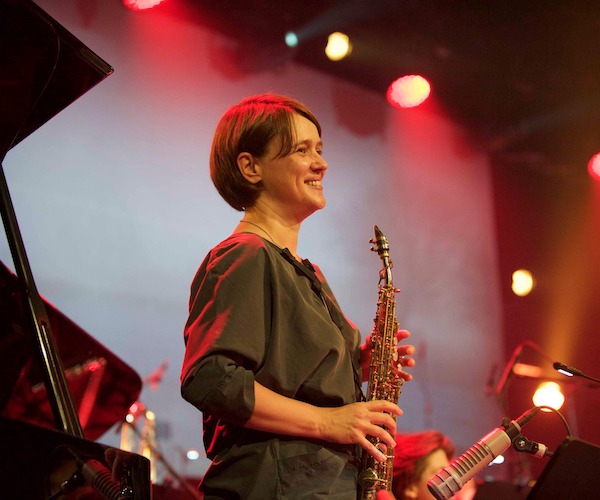Jazz Album Review: Ingrid Laubrock’s “The Last Quiet Place” — Searching for Inner Purpose
By Michael Ullman
The album seems to me to be about spotlighting the ensemble’s sound rather than the virtuoso displays of its leader.
Ingrid Laubrock, The Last Quiet Place (Pyroclastic)

Cover art for The Last Quiet Place.
Saxophonist Ingrid Laubrock made her first recordings in London in the late ’90s. Her first album as a leader was Who Is It?, made for Candid Records in 1997. Even then, her musical interests were wide-ranging: on 1997’s Let’s Call This she performs tunes by Monk, Mingus, Ellington, and Lee Konitz, along with originals and standards. She was on Kris Davis’s amusingly titled Paradoxical Frog and has recorded with Anthony Braxton.
Ingrid Laubrock’s new album on Kris Davis’s Pyroclastic Records contains six originals. She set out her goals in a recent statement: “I am always searching to maintain a sense of clarity and purpose.” The trouble is, according to the saxophonist/ composer, “we’re in turmoil all the time.… It can be true turmoil or invented turmoil — we’re all addicted to the news cycle and constantly online, having signals sent to our brain that we must be alert and worried at all times, when it actually serves us better not to be.” The last quiet place, inevitably, is “within yourself,” yet “even finding that seems impossible much of the time.” Laubrock wrote the pieces found on this disc when sitting (quietly) at a coffee house and while hiking.
The personnel on The Last Quiet Place is unusual if not unprecedented. It features violinist Matt Swift, cellist Tomeka Reid, and bass player Michael Formanek: it is a kind of string quartet once guitarist Brandon Seabrook is added in. The sixth member is drummer Tom Rainey. The music they play is restless, its textures constantly shifting in fascinating ways. There’s a moment in “Delusions” when everything comes to a stop. Subsequently, we hear what sounds to me like a wall of crickets. (It seems to be a tremolo played high by the violinist.). What’s remarkable is that, for all the shifts and turns in the music and rearrangements of the personnel, it sounds coherent, intriguingly so.
The collection opens with a splash on the guitar and then “Anticipation”‘s lovely theme, stated by cello and violin and soprano. Oddly, the tune generates anticipation by repeatedly starting with a strumming on the guitar, which gives way to the others who wind down to a new silence. Eventually Laubrock is soloing over bassist Formanek before there’s a kind of eruption from the band. This too fades into what sounds like the ringing of bells. That’s not all. Guitarist Seabrook plays a clear single-note descending pattern and the piece seems to start up again, this time in conversation with the guitar riff. The ensemble playing here, and elsewhere, is remarkable. At times bassist Formanek seems to be finishing Seabrook’s phrases; the tense pluckings by Tomeka Reid responding to Laubrock’s phrases. This is a band of stars, all leaders, who are dedicated to the sound of the ensemble.

Saxophonist/composer Ingrid Laubrock. Photo: VCFA MFA in Music Composition
The anxiously upbeat “Grammie Season,” with its sometimes herky-jerky movement, follows. Passages of dramatic long tones alternate with the album’s more characteristic staccato playing. A long group improvisation features Seabrook playing fiercely in the right channel while Reid and Swift hold forth on the left. This ends with a high-pitched tone emerging over the sudden quiet. The strings then take over before bass and drums improvise an end to that section. In “Afterglow” Laubrock performs at length over her longtime collaborator, drummer Rainey. Even here she seems to play in what I will call the opposite of the sheets of sound technique. (She’s Miles Davis rather than John Coltrane.) Laubrock solos in thoughtful spurts; she fits her phrases into the ensemble even as she leads it in new directions.
“The Last Quiet Place” is just as restless as the other compositions. It begins with the pit-a-pat of the brushes on the snare, a repeated note on guitar, and long lines on violin. Everything stops while the violin plays. Laubrock enters on soprano and makes carefully stated comments that sometimes sound like laments. Her voice may be representative of the album’s perpetually threatened quiet place. The ensemble never settles down in the face of her phrases, however sweetly melancholic. In a new section, Reid and Swift play in unison over the bass. Compared to the title cut, “Delusions” is a kind of uptempo group assault. Afterglow begins with an extended duet between tenor saxophone and drums. The set ends with its longest number, “Chant II.” (“Chant I” must be found elsewhere.) The piece — indeed the entire session — seems to me to be about spotlighting the ensemble’s sound rather than the virtuoso displays of its leader. And The Last Quiet Place‘s collaborative product is a wide-awake, living kind of thing, neither esoteric nor prematurely patterned. In fact, the togetherness can be amusing, as when “Delusions” comes to an abrupt stop — only to restart with Seabrook playing a goofy phrase that is repeated while the drummer solos and Laubrock interjects what sound like outraged squawks. That’s the way the piece ends … not with a bang but a giggle.
Michael Ullman studied classical clarinet and was educated at Harvard, the University of Chicago, and the U. of Michigan, from which he received a PhD in English. The author or co-author of two books on jazz, he has written on jazz and classical music for the Atlantic Monthly, New Republic, High Fidelity, Stereophile, Boston Phoenix, Boston Globe, and other venues. His articles on Dickens, Joyce, Kipling, and others have appeared in academic journals. For over 20 years, he has written a bi-monthly jazz column for Fanfare Magazine, for which he also reviews classical music. At Tufts University, he teaches mostly modernist writers in the English Department and jazz and blues history in the Music Department. He plays piano badly.
